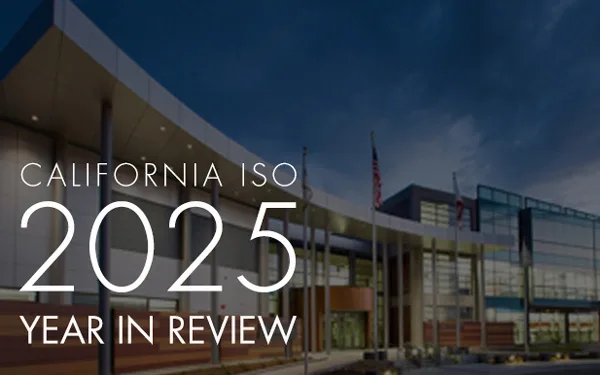Working with stakeholders toward a “significantly reformed interconnection process”

Since working with stakeholders to identify the best ways to address overheated interconnection queues in 2022 and 2023, the California Independent System Operator (ISO) recently released its new Straw Proposal designed to greatly improve the overall efficiency of getting new resources connected to the grid.
The ISO’s need for interconnection reform is profound, but not unique, as interconnection queues across the country are facing new challenges. In response to these challenges, the Federal Energy Regulatory Commission (FERC) in July issued Order No. 2023, “Improvements to Generator Interconnection Procedures and Agreements,” which will transition regulated entities to a “first-ready, first-served” interconnection process through a number of new requirements.
The ISO intends to comply with this order as quickly and completely as possible, and plans to apply Order No. 2023 to Cluster 15, our latest set of interconnection requests. We are now in Track 2 of the Interconnection Process Enhancements (IPE) Initiative where we will focus on issues that are more unique to the ISO and additional to new FERC requirements. Under the proposed new approach, and consistent with FERC Order No. 2023, interconnection requests will have to meet new requirements to demonstrate site control. These measures, along with new elements of the Straw Proposal, will prioritize the most commercially ‘ready’ projects for progress to the interconnection study process.
Given the urgent need to bring unprecedented amounts of new capacity online over the next decade and beyond, the Straw Proposal incorporates feedback from stakeholders to propose a significantly reformed interconnection process that emphasizes project viability and competition for resources identified in local and state resource planning efforts.
The proposed changes outlined in the Straw Proposal seek to enable rapid deployment of new generation for reliability, affordability, and decarbonization, aligning with the strategic direction established by a Memorandum of Understanding (MOU) signed last December by the ISO, California Public Utilities Commission (CPUC), and California Energy Commission (CEC). Like the MOU, the IPE Straw Proposal reflects the intention to strengthen connections between resource and transmission planning, resource procurement, and interconnection processes.
Central to the proposal is the zonal approach, which encourages interconnections in established transmission zones with available and planned transmission plan deliverability (TPD). This approach provides a natural incentive for project development and procurement of projects in areas where resources are needed, based on state and local resource plans. The ISO will continue to work with state agencies, local regulatory authorities, load-serving entities, and other stakeholders to consider opportunities for deeper integration of procurement activities earlier in the interconnection process.
Prior to the opening of the interconnection request window, the ISO will provide information that identifies priority zones. Generation projects seeking to interconnect outside of the priority zones may proceed as Option B projects. This ensures that projects seeking to interconnect in areas with no available deliverability capacity have a path forward.

The Straw Proposal incorporates stakeholder suggestions to score each interconnection request based on a set of clear and verifiable criteria used to rank the projects for progression to the study process. If excess proposed capacity exists in certain transmission zones after applying the readiness scores, the ISO would conduct a market-clearing, sealed-bid auction for the right to be prioritized and studied in a specific zone. In response to stakeholder feedback and sensitivity to ratepayer costs, the ISO designed the auction to minimize the fiscal impact on ratepayers, with auction revenues used to fund transmission upgrades. Under this proposal, successful projects would progress to a reformed study process that is consistent with FERC Order No. 2023.
Acknowledging the typically long timeframes of most transmission development projects, the ISO and stakeholders recognize the importance of working together to modify the transmission plan deliverability allocation process and develop a methodology to enable multi-year interim deliverability to align Local Delivery Network Upgrades (LDNUs) with requested commercial online dates. Given the importance of obtaining deliverability in today’s market, the ISO expects this to be a topic of additional stakeholder discussions as we work together in the coming months to develop the draft final proposal.
To address projects currently in the ISO’s interconnection queue, the Straw Proposal includes a one-time opportunity for interconnection customers to withdraw projects from the queue and receive, over time, any unused portion of their interconnection financial security postings.
The ISO also proposes changes that will require projects in the queue to either perform or withdraw, by advancing to an interconnection agreement and posting a third financial security within an established timeframe. This places a financial obligation on the project if it desires to remain in the queue, and motivates a decision to withdraw if it can’t or won’t proceed to an executed interconnection agreement.
These process reforms, described in greater detail in the Straw Proposal, are designed to accelerate progress toward execution of an interconnection agreement and commercial operations for the most viable and competitive projects in areas that align with local and state resource plans. The ISO looks forward to ongoing engagement with stakeholders to refine this proposal in a manner that complies with new FERC requirements, addresses current market dynamics, and aligns with the broader vision outlined in the MOU.


